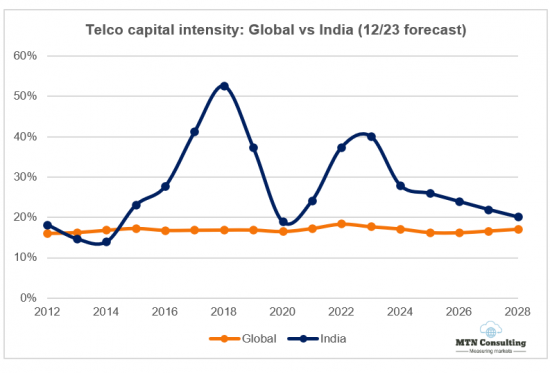
|
시장보고서
상품코드
1398379
네트워크 사업자 예측(-2028년) : 2023년 하락 이후 설비투자 회복, 2028년 약 6,500억 달러로 성장, 생성형 AI가 설비투자와 인력 감축을 모두 촉진할 전망Network Operator Forecast Through 2028: After 2023 Dip, Capex Will Bounce Back, Growing to Reach ~$650B by 2028, GenAI Will Drive Both Capex and Job Cuts |
||||||
3개 네트워크 사업자의 매출은 2024년 4조 3,800억 달러(2022년 4조 1,100억 달러)에 달할 것으로 예상됩니다. 또한 설비투자는 5,520억 달러(2022년 5,630억 달러), 직원 수는 871만 명(2022년 888만 명)에 달할 것으로 예측됩니다.
본 보고서에서는 세계 네트워크 사업자 시장(통신사, 웹 스케일러, 캐리어 중립 네트워크 사업자(CNNO) 등)의 실적 및 설비투자 동향 전망에 대해 분석했으며, 총 175개사 이상의 최신 실적 동향(매출, 설비투자금액, 직원수 등, 2011-2022년) 및 향후 전망(-2028년)을 분기별로 조사, 추정하고, 부문별 상세 동향과 과거 예측 결과와의 비교 등의 정보를 정리하여 전해드립니다.
VISUALS


전체 물량 기준 분석 결과
통신사, 웹스케일, 캐리어 뉴트럴 3개 부문의 총 매출은 2022년 4조 1,090억 달러, 2028년 5조 3,440억 달러로 성장하고, 3개 부문의 설비투자는 2022년 5,630억 달러에서 2023년과 2024년 모두 약 5,500억 달러로 감소할 것으로 예상했습니다. 웹스케일의 설비투자는 최근 정체되어 있지만, 장기적으로 볼 때 이 부문은 네트워크 사업자 성장의 대부분을 차지하고 있습니다. 2022년에는 36%, 2028년에는 43%를 넘어설 것으로 예상되며, CNNO는 2028년 설비투자액의 7%를 차지해 현재보다 소폭 증가하겠지만, 통신사도 2028년 네트워크 사업자 설비투자액의 50% 미만을 차지할 것으로 예상됩니다. 자본집약도를 보면, 전체 사업자 평균은 2022년 13.7%였으나 2028년에는 12.4%에 불과합니다. 통신기업이 이러한 움직임의 주요 원인으로 작용하고 있습니다. 통신사의 연환산 자본집약도는 2023년 1분기 18.7%로 정점을 찍고, 대부분의 5G 네트워크가 구축된 현재 빠르게 하락하기 시작했습니다. 자본집약도는 2027년부터 다시 상승하기 시작해 2028년에는 17.1%를 나타낼 것으로 예상되며, 웹 스케일러도 2022년 자본집약도가 9.1%로 사상 최고치를 기록했지만 현재는 완화되는 추세입니다. 그러나 사업자들이 기존 데이터센터를 가득 채우면서 웹스케일러의 설비투자 중 네트워크에 투자되는 비율은 상승하고 있습니다. 자본 집약도는 예년과 마찬가지로 캐리어 중립이 가장 높으며, 전체 예측 기간 동안 30%를 훨씬 상회합니다.
3개 사업자 부문의 전체 직원 수는 지난 10년간 급격히 증가하여 2011년 648만 명에서 2022년 888만 명으로 늘어날 것으로 예상됩니다. 이는 2021년 수치와 거의 동일하며, 2022년 통신업체들이 인력 감축을 가속화하고 일부 웹 스케일러가 해고를 발표했으며, 2023년 총 인원은 876만 명으로 전년 대비 다소 감소할 것으로 예상되는데, 이는 주로 현재 진행 중인 통신업체들의 인력 감축에 기인합니다. 앞으로는 생성형 AI의 기여로 인해 통신사의 감원이 다소 가속화될 것으로 예상되며, 웹 스케일러는 2025년까지 소폭 성장할 것이지만 그 이후에는 꾸준히 감소할 것으로 보입니다. 특히 아마존이나 JD.Com과 같은 전자상거래 중심의 웹 스케일러의 경우, 로봇과 AI에 대한 수년간의 대규모 R&D 투자가 이제야 결실을 맺기 시작하면서 인건비 절감으로 이어질 것으로 보이며, CNNO의 고용 인원은 10만 명에 불과할 것으로 보입니다. 부문별로는 2023년 기준 직원 1인당 매출은 웹스케일이 56만 2,000달러, 통신기업이 39만 1,000달러인 반면 CNNO는 약 87만 6,000달러로 압도적으로 높으며, 2026년 노동인구가 감소세로 돌아서기 때문에 이 지표의 성장은 웹스케일이 가장 높습니다. 웹 스케일에서 가장 높을 것입니다. 직원 1인당 매출 성장률은 인력 감축에 대해 상당히 공격적인 가정이 있더라도 통신 기업이 가장 느리게 성장합니다. 또 다른 시나리오는 통신사 경영진이 특히 영업 및 마케팅 부문의 단기적인 인력 감축을 지원하기 위해 생성형 AI를 적극적으로 도입하는 것으로, BT는 이 시나리오를 지적한 통신사 중 하나입니다. 그러나 대부분의 통신사들은 네트워크 운영과 같은 민감한 분야에 생성형 AI를 즉각적으로 도입하는 데는 신중할 것으로 보입니다.
주요 분석 결과: 네트워크 사업자 유형별
이 예측에는 세 가지 네트워크 사업자 유형별로 상세한 분석이 포함되어 있습니다. 다음은 부문별 주요 조사 결과를 요약한 내용입니다.
통신 기업: 우리가 계속 말했듯이, 통신 사업은 기본적으로 제로 성장 산업입니다. 특정 국가나 기업은 시장 점유율의 변화, 성장주기의 차이, M&A 등으로 인해 간혹 성장하기도 합니다. 하지만 2011년 이후 세계 통신기업들의 매출은 좁은 범위(1조 7,000억 달러에서 1조 9,000억 달러)에서 움직이고 있으며, 이는 2028년까지 지속될 것으로 보입니다.2022년 매출은 1조 7,800억 달러, 2023년 소폭 감소하고 이후 연평균 1.4% 성장해 2028년에는 1조 9,300억 달러에 달할 것으로 보입니다. 설비투자는 기술 업데이트 주기(예: 5G)와 정부의 움직임(예: 신규 주파수 대역 제공 및 지방 광섬유 보조금)에 따라 계속 변화하고 있으며, 2022년 총 설비투자는 3,280억 달러로 매출의 18.1%를 나타낼 것으로 예상됩니다. 이는 우리가 다루는 기간(2011-현재) 동안 연간 자본 집약도가 사상 최고치를 기록한 것입니다. 그러나 설비투자는 2025년까지 소폭 감소했다가 2028년 3,310억 달러(자본집약도 17.1%)로 다시 소폭 상승할 것으로 예상됩니다. 미국의 설비투자는 2022년에 급증했지만 2023년과 2024년 모두 크게 감소할 것입니다. 소프트웨어 설비투자는 예상보다 완만하게 증가하여 예측 기간 동안 전체 설비투자의 20% 미만에 머무를 가능성이 높습니다. 통신 산업 종사자 수는 예상보다 빠른 속도로 감소하고 있으며, 2022년 460만 명 미만에서 2028년 420만 명 이하로 떨어질 것으로 보입니다. 1인당 인건비는 통신사들이 IT/소프트웨어 중심의 인력을 양성함에 따라 2023년부터 다시 성장세로 돌아설 것으로 보입니다.
웹 스케일러:지난 10년간 웹 스케일러의 성장은 전체 네트워크 사업자 시장을 견인해 왔으며, 코로나 기간 동안 웹 스케일러는 매출, 설비투자, 고용 등 모든 지표가 급성장했습니다. 데이터센터 칩 및 관련 장비에 대한 수요도 급증했습니다. 그러나 이 부문은 작년에 성장이 둔화되어 비용, 설비 투자, 인력 감축을 추진하고 있습니다.2023년 매출은 약 2조 3,200억 달러로 2년 연속 전년 대비 4% 증가에 그칠 것으로 예상됩니다.2028년까지 CAGR은 약 7%로 예상됩니다.2022년 웹스케일 설비 투자 금액은 2,030억 달러에 달할 것으로 예상됩니다. 030억 달러로 2021 년부터 건전하게 증가했습니다. 그러나 설비투자는 2024년 말까지 소강상태를 유지하다가 몇 년간의 용량 흡수 후 2025년부터 다시 증가하기 시작할 것으로 보입니다. 이 기간 동안 설비투자의 대부분은 네트워크/IT/소프트웨어에 투자될 것이며, 웹 스케일러의 R&D 비용은 높은 수준을 유지하겠지만, 2022년 기록적인 수준(매출의 12.0%)에서 2028년에는 10% 이상으로 감소할 것으로 보입니다. 탑라인의 성장이 어려워짐에 따라 비용에 대한 인식과 단기 지향성이 강화될 것으로 보입니다.
캐리어 중립: 캐리어 중립 부문은 2022년 매출이 950억 달러로 여전히 작지만 2028년에는 약 1,240억 달러로 성장할 것이며, 웹 스케일러와 통신사 모두 데이터센터, 타워, 파이버 설치 면적을 확대하기 위해 CNNO에 의존할 것으로 보입니다. 확대하기 위해 CNNO에 대한 의존도를 높여갈 것으로 보입니다. 통신사들은 기존 CNNO(예: Zain과 Ooredoo로부터 3만 개의 타워를 인수한 TASC Towers)나 AT&T와 Blackrock의 파트너십인 Gigapower와 같은 조인트벤처와 같이 인프라의 일부를 제3자에게 매각할 것으로 보입니다. 2022년 CNNO의 총 설비투자는 미화 33억 달러, 2028년에는 약 45억 달러로 확대될 것으로 예상되며, 2028년까지 CNNO 부문은 약 380만 개의 셀 타워(2022년: 330만 개), 1,718개의 데이터센터(2022년: 1,223개), 113만 마일의), 113만 마일의 광섬유 노선(2022년: 94만5,000마일)을 관리하고 있습니다.
대상범위
대상 기업
|
|
목차
본 보고서의 주요 섹션 :
- 1. 개요
- 2. 네트워크 사업자 합계
- 3. 통신 기업
- 4. 통신 기업 - 지역별 분석
- 5. Web 스케일
- 6. 캐리어 뉴트럴(CNNO)
- 7. 대형 사업자의 지출 전망
- 8. 개요
본 보고서 중 주요 분석 결과 탭 - '네트워크 사업자 합계', '통신 기업', '통신 기업 - 지역별 분석', 'Web 스케일', '캐리어 뉴트럴(CNNO)' -에는 분석 결과가 다수 게재되어 있습니다.
'네트워크 사업자 합계' 탭에 게재된 수치 리스트 :
- 설비투자비용 예측, 부문별 : 2023년 12월과 2022년 12월 전망, 교차(단위 :%)
- 설비투자비용 예측, 부문별 : 2023년 12월과 2022년 12월 전망, 교차(단위 : 10억 달러)
- 매출 성장률, 전체 사업자 : 신구 예측
- 매출 성장률, 통신 기업 : 신구 예측
- 자본 집약도, 통신 기업 : 신구 예측
- 자본 집약도, Web 스케일러 : 신구 예측
- 자본 집약도, CNNO : 신구 예측
- 매출, 사업자 유형별(단위 : 10억 달러, 2011년-2028년)
- 설비 투자, 사업자 유형별(단위 : 10억 달러, 2011년-2028년)
- 설비 투자, 사업자 유형별(전체%, 2011년-2028년)
- 자본 집약도, 사업자 유형별(2011년-2028년)
- 직원 수 : 사업자 유형별
- 직원 1인당 매출 : 사업자 유형별(단위 : 1000달러)
- 네트워크 사업자 매출 : 유형별, 세계(GDP 대비)
- 네트워크 사업자 직원 및 세계 인구 비율
- 통신 기업 매출과 가입자 1인당 설비투자 비용(2011-2022년)
- 지출액 상위 사업자 50개사 : 연액 환산 자본 투자액(단위 : 10억 달러, 2023년 3분기)
- 상위 사업자 50개사 : 장기적인 자본 집약도(평균치, 2019년 4분기-2023년 3분기)
This forecast report presents our latest projections for the network operator market, spanning telecommunications operators (telcos), webscalers, and carrier-neutral network operators (CNNOs). The forecast is based on our quarterly coverage of over 175 operators. Our forecast includes revenues, capex and employee totals for all segments, and additional metrics for each individual segment. In 2024, we expect the three operator groups to account for $4.38 trillion (T) in revenues (2022: $4.11T), $552 billion (B) in capex (2022: $563B), and 8.71 million (M) employees (2022: 8.88M). This report provides 2011-22 actuals and projections through 2028, and includes projections from past forecasts for reference.
VISUALS

Top line quantitative results
Revenues from the aggregate of our three segments - telco, webscale, and carrier-neutral - were $4,109 billion (B) in 2022, and will grow to $5,344B by 2028. Three segment capex ended 2022 at $563B, will fall to ~$550B for both 2023 and 2024, then grow to $662B in 2028. Webscale capex has flattened recently but over the longer timeframe this sector accounts for most network operator growth. In 2011, webscale was less than 10% of capex, but exceeded 36% in 2022 and will be over 43% by 2028. CNNOs will represent 7% of 2028 capex, a bit more than today, while telcos will capture just under 50% of expected 2028 network operator capex. In capital intensity terms, the all-operator average was 13.7% in 2022 but that will be just 12.4% in 2028. That's largely because of telcos: their annualized capital intensity peaked at 18.7% in 1Q23 and has begun to come down rapidly, now that most 5G networks are built. That will start to come back in 2027 and hit 17.1% in 2028. Webscalers also saw an all-time high capital intensity in 2022, of 9.1%, which is now easing. The portion of webscalers' capex spent on the network is rising, though, as operators fill up existing data centers. Capital intensity is highest in carrier-neutral, as usual, well over 30% for the whole forecast period.
Headcount across the three operator segments has grown dramatically in the last decade, from 6.48 million in 2011 to 8.88M in 2022. That is roughly the same as the 2021 figure: telcos accelerated headcount reductions in 2022, and several webscalers announced layoffs. In 2023, total headcount will be 8.76M, a bit down YoY, due mainly to ongoing telco cuts. Looking forward, we expect telco reductions to slightly accelerate, with contributions from GenAI. Webscalers will grow a bit through 2025 but then headcount will begin to decline steadily. All the years of big R&D investments into robotics and AI will start to really pay off after this, lowing workforce costs, especially for the ecommerce-oriented webscalers like Amazon and JD.Com. CNNO employment will stay just above 100,000. By segment, revenue per employee is by far the highest in CNNO, at ~$876K in 2023, versus $562K for webscale and $391K for telco. Growth in this metric will be highest in webscale, though, as the workforce starts to shrink in 2026. Telcos' growth in revenues per employee is the slowest, even with our fairly aggressive assumptions about job cuts. There is another scenario possible, in which telco execs implement GenAI aggressively in order to support near-term layoffs, especially in sales & marketing; BT is one telco which has pointed to this scenario. Most telcos will be cautious about immediate GenAI implementation for sensitive areas such as network operations, though.
Key findings by network operator type
This forecast includes detailed breakouts for each of the three network operator types. Here is a summary of some of the key findings, by segment:
Telcos: as we keep saying, telecom is essentially a zero-growth industry. Specific countries and companies do grow from time to time, in part from market share shifts, the different timing of growth cycles, or M&A. But global telco revenues have hovered in a narrow range ($1.7-$1.9 trillion) since 2011, and this will likely remain true through 2028. In 2022, revenues were $1.78T, will fall a bit in 2023, then will grow an average annual rate of 1.4% to reach $1.93T by 2028. Capex continues to vary with technology upgrade cycles (e.g. 5G) and government actions (e.g. newly issued spectrum, or rural fiber subsidies). In 2022, capex totaled $328B, or 18.1% of revenues; that's an annual all-time high capital intensity, for our coverage timeframe (2011-present). Capex will decline slightly through 2025, though, and then rise modestly again to reach $331B in 2028, which would be a 17.1% capital intensity. US capex surged in 2022, but will drop significantly in both 2023 and 2024; we already expected this, though, so the current forecast is not significantly different. Software capex is growing more slowly than expected, and now likely to remain under 20% of total capex for the forecast period. Headcount in telecom is declining faster than expected, and now likely to fall below 4.2 million in 2028, from just under 4.6 million in 2022. Labor costs per head will revert to a growth trajectory in 2023, as telcos develop a more IT/software-centric workforce.
Webscalers: growth from webscale has lifted the overall network operator market over the last decade. Webscalers surged during COVID, by all measures - revenues, capex, employment. Demand for data center chips and related gear also surged. The sector saw slower growth last year, though, and is cutting back on costs, capex, and headcount. In 2023, revenues will be about $2.32 trillion, up just 4% YoY for the second straight year. We expect revenues to grow at a ~7% CAGR through 2028. Webscale capex was $203B in 2022, a healthy increase from 2021; capex will be in a holding pattern through end of 2024 though, allowing for a couple years of capacity absorption, and start to grow again in 2025. During the lull, a larger portion of capex will be for Network/IT/software investments R&D spending by webscalers will remain high but fall from the record-breaking level of 2022 (12.0% of revenues), to a bit over 10% in 2028. As topline growth gets harder for webscalers, they will become more cost conscious and short-term oriented.
Carrier-neutral: the carrier-neutral sector remains tiny, with just $95B in 2022 revenues, but will grow to about $124B by 2028. Webscalers and telcos alike will both rely more on CNNOs over time for expansion of their data center, tower and fiber footprints. Telcos will continue to spin out portions of their infrastructure to third-parties - both traditional CNNOs (e.g. TASC Towers, which just bought 30,000 towers from Zain and Ooredoo), and joint ventures like Gigapower, the AT&T-Blackrock partnership. Total CNNO capex for 2022 was $33B, and will grow to about $45B by 2028; a large chunk of the CNNO sector's expansion will be inorganic, though, via acquisition of existing assets from other sectors. By 2028, the CNNO sector will have under its management approximately 3.8 million cell towers (2022: 3.3M), 1,718 data centers (2022: 1,223), and 1.13M route miles of fiber (2022: 945K).
Key changes since last forecast
We publish a full forecast every 6 months. Here are some factors we considered in developing this latest forecast update:
Macroeconomics: Interest rates have risen a bit more, inflation shows signs of cooling, but economic growth forecasts from the IMF remain lackluster: "The baseline forecast is for global growth to slow from 3.5 percent in 2022 to 3.0 percent in 2023 and 2.9 percent in 2024, well below the historical (2000-19) average of 3.8 percent."
Generative AI: interest and adoption of generative AI (GenAI)-based tools and apps has continued to accelerate, and operators increasingly point to GenAI as a driver for infra investment, especially in the data center. The initial impact is to drive the carrier-neutral market, enticing more investment from private equity firms to have a position in the market. There is a lot of unmeasured private market activity in the data center market, and ongoing pull from PE firms to take assets private (e.g. in 2023, Bain-ChinData, and Brookfield-Cyxtera). GenAI will help webscale capex to lift off again starting 2025.
Telco business models: Telcos continue to spin off assets and search for new business models as 5G revenue growth fails to materialize. Among the many examples: in August 2023, Austria's A1 Telkom divested a portfolio of 12,900 cell towers across 5 countries, allowing it to shed 1B Euros in debt; also in 3Q23, Polish operator Polsat made strides in scaling up its new renewable energy business line, signing a deal to sell wind-generated power to Google, commissioning 2 wind farms, one solar farm, and 2 public hydrogen refueling stations. Expansion into new markets like energy requires new capex, but that is possible for telcos who choose to move towards an asset-light business model by selling off passive assets.
Telco capex: Telcos were already guiding down capex for 2024, but the guidance became even more negative with 2Q23 and 3Q23 earnings releases. Telco capex fell 8% YoY in 3Q23, and revenues for vendors selling into the telco market fell by over 10% YoY (preliminary). We already expected capex to start to decline in 2023, but it's started a bit sooner than expected. Telcos are pushing on every cost lever they can find, whether opex- or capex-related. The smarter ones are accepting that, as we expected, webscalers and other tech players are likely to reap most of the spoils of the world's new 5G networks. Telco execs need to stick to their knitting.
Headcount: Employment levels continue to go down steadily in the telecom industry, and have plateaued in the webscale sector. There is a lot of enthusiasm among execs in the potential for GenAI to reduce headcount levels, including in the telecom industry; we have increased the rate of employee attrition in this market.
Conflict: Russia's war on Ukraine remains ongoing, but hasn't expanded to new countries. China has not invaded Taiwan as of yet, although this is a serious risk over the 5-year forecast horizon.
Climate change: global warming news continues to worsen. Intergovernmental efforts to address it are still disappointingly watered down and toothless, as the recent COP28 event confirmed. Private efforts are full of greenwashing and baby steps. Many industries are taking real change slowly, in hopes that someone else will do the heavy lifting. Within our universe of operators, there are a few webscalers and CNNOs with impressive environmental records, though most of these built their networks from scratch in the last decade. The telco market is a problem; it needs to do more in 2024. Converting to 100% renewable energy as fast as reasonable will soon be on every operator's agenda, and this will come with some upfront investment. We don't forecast energy-related capex, but we do expect green energy to account for a growing share of capex budgets over time. Offsetting this capex burden is that early moving operators will be able to stabilize their energy spending, boost their green credentials legitimately, and possibly develop a new business line (for examples, see China Tower, Indus, and Polsat).
The net impact of these factors can be seen in the individual forecast tabs within this report.
COVERAGE
Companies mentioned:
|
|
Table of Contents
Key sections include:
- 1. Abstract
- 2. Network Operator Totals
- 3. Telco
- 4. Telco - Regional Splits
- 5. Webscale
- 6. Carrier-neutral (CNNO)
- 7. Spending outlook for top operators
- 8. About
This report has a large number of figures on each of the main result tabs: totals, telco, telco - regional splits, webscale, and carrier-neutral (CNNO).
A list of figures on the "Totals" tab:
- Capex forecast by segment: Dec 2023 v. Dec 2022 outlook, % difference
- Capex forecast by segment: Dec 2023 v. Dec. 2022 outlook, $B difference
- Revenue growth rates, all operators: New vs. old forecast
- Revenue growth rates, Telcos: New vs. old forecast
- Capital intensity, Telcos: New vs. old forecast
- Capital intensity, Webscalers: New vs. old forecast
- Capital intensity, Carrier-neutral operators: New vs. old forecast
- Revenue by operator type, 2011-28 (US$B)
- Capex by operator type, 2011-28 (US$B)
- Capex by operator type, 2011-28: % of total
- Capital intensity by operator type, 2011-28
- Employees by operator type (M)
- Revenues/employee by operator type (US$K)
- Network operator revenues by type, % global GDP
- Network operator employees (M), and % global population
- Telco revenues and capex per sub, 2011-22
- Top 50 spending operators, annualized 3Q23 capex ($B)
- Top 50 operators based on long-term capital intensity (4Q19-3Q23 avg)



















